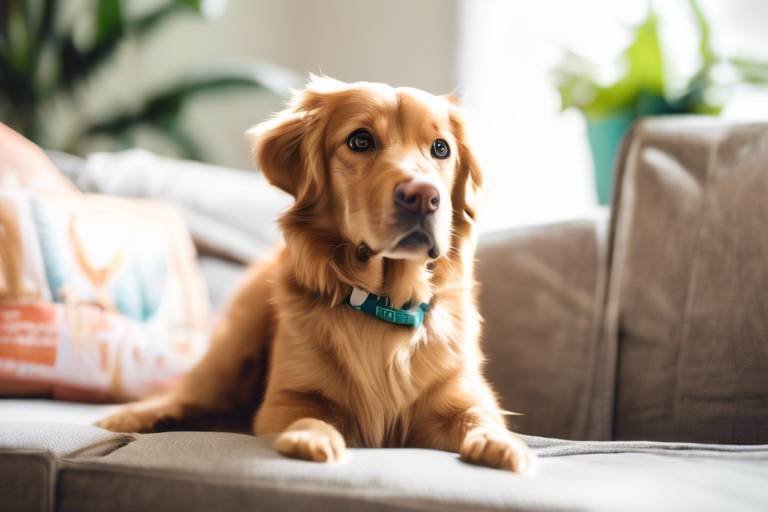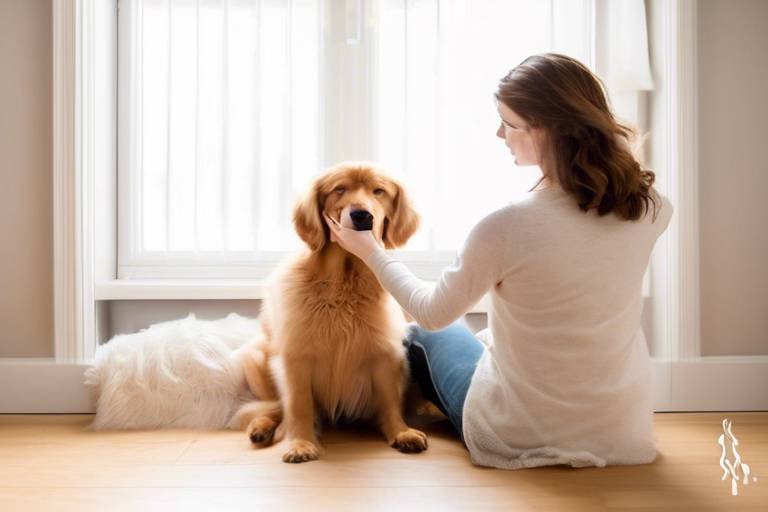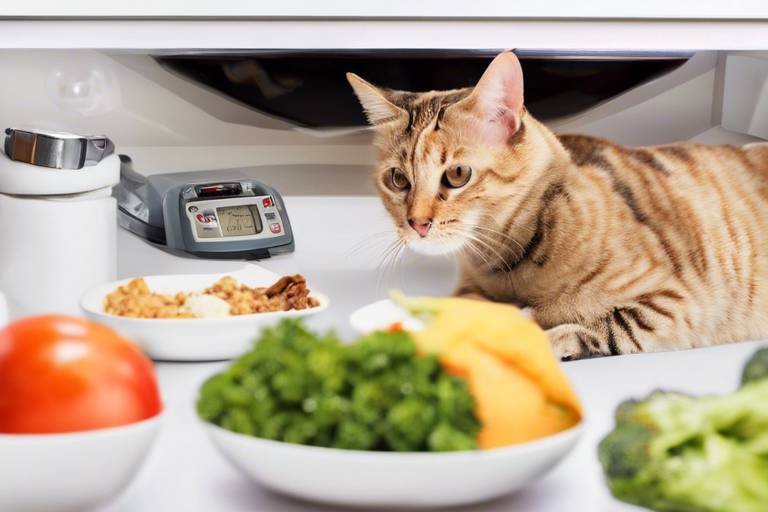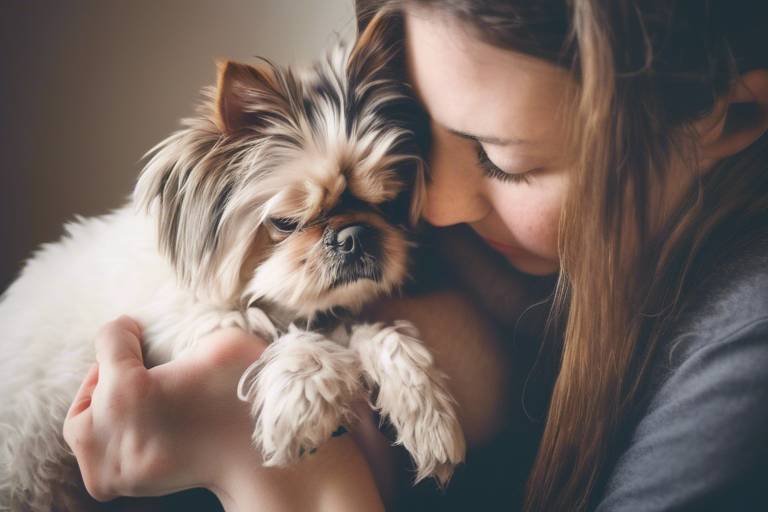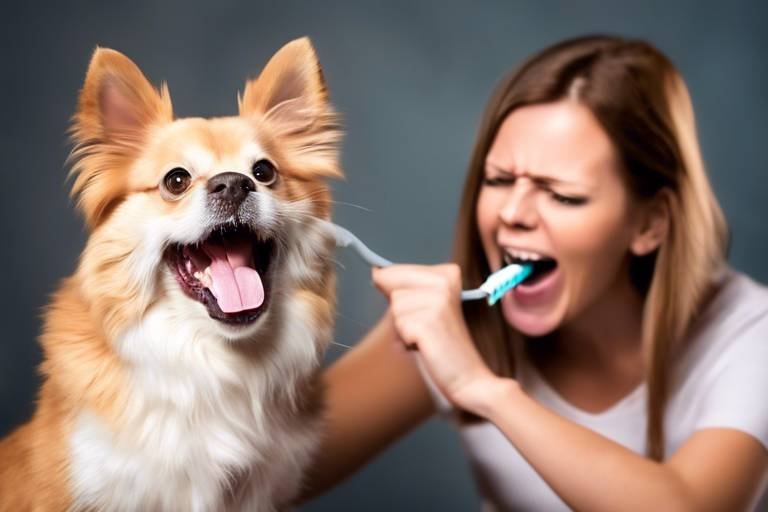How to Help Your Pet Adjust to Changes in the Home
Change is a part of life, and while we humans might embrace it, our pets often find it a bit more challenging. Whether it’s moving to a new house, welcoming a new family member, or even rearranging furniture, these changes can create a whirlwind of emotions for our furry friends. So, how can we ensure that our pets feel safe and secure during these transitions? This article dives into effective strategies that can help your pet adjust to changes in their living environment, ensuring their comfort and well-being during these times of upheaval.
Recognizing how pets react to changes is crucial. Pets, just like us, have their own unique personalities and ways of expressing stress. Some might become clingy, while others may retreat into their shells. By keenly observing their behavior, you can identify signs of stress and anxiety. For instance, if your dog suddenly refuses to eat or your cat hides under the bed, these could be indicators that they are feeling overwhelmed. Understanding these signals allows you to address their needs more effectively, ensuring that they feel supported and loved during difficult moments.
Establishing a designated area for your pet can provide them with a sense of security. This space should be familiar and comforting, allowing them to retreat when feeling overwhelmed. Think of it as their little sanctuary—a place where they can relax and feel at ease. To create this safe space, consider incorporating familiar items that carry their scent, such as toys, bedding, and blankets. These items can help ease your pet's anxiety and provide a sense of normalcy during the transition.
Including familiar items in your pet's safe space is essential. These items might include:
- Toys: Their favorite chew toy or a cuddly stuffed animal can provide comfort.
- Bedding: A cozy bed or blanket that smells like them can help them feel secure.
- Personal Items: Anything that has been a part of their routine can help maintain a sense of familiarity.
Selecting a quiet and low-traffic area in your home for your pet's safe space is key. This will minimize disturbances and help your pet feel more secure. Ideally, this area should be away from the hustle and bustle of daily life, allowing your pet to retreat and relax without interruptions.
Consistency is key for pets. Keeping feeding, walking, and playtime schedules regular can help them adjust more smoothly to changes in their environment. Imagine if your daily routine suddenly changed; it would feel disorienting, right? The same goes for our pets. By maintaining a routine, you provide them with a sense of stability and predictability, which can be incredibly comforting during times of change.
When introducing your pet to new spaces, do so gradually. Start with short visits and gradually increase the time spent in unfamiliar areas to prevent overwhelming them. Think of it like dipping your toes into a pool rather than jumping in headfirst. This slow approach allows your pet to acclimate to their new surroundings at their own pace, reducing anxiety and fostering a sense of security.
Using positive reinforcement can encourage your pet to explore and adapt to changes. Rewarding them for calm behavior can help build their confidence in new situations. For example, if your pet bravely explores a new room, offer them a treat or some praise. This not only reinforces positive behavior but also helps them associate new experiences with good feelings.
Incorporating short training sessions can help redirect your pet's focus and provide mental stimulation. This can be particularly beneficial during times of stress or change. Think of training as a fun game that keeps your pet engaged and distracted from their worries. Plus, it strengthens the bond between you and your furry friend, making them feel more secure in your presence.
Strategically using treats can motivate your pet to engage with new environments. Ensure that the treats are healthy and appropriate for your pet's dietary needs. Instead of just giving them a treat randomly, try to associate it with positive experiences in new areas. This way, your pet will learn to look forward to exploring rather than fearing it.
Changes in the home can impact your pet's physical and mental health. Regular check-ups with a veterinarian can help ensure your pet remains healthy during transitions. Just like us, pets can experience stress that manifests in various ways, including changes in appetite or behavior. Keeping an eye on their health is vital during these times.
Being aware of stress indicators is essential. Look out for signs such as:
- Excessive barking or meowing
- Hiding or seeking solitude
- Changes in appetite or drinking habits
Early intervention can help address any issues before they escalate, ensuring your pet remains happy and healthy.
If your pet struggles significantly with changes, seeking advice from a professional trainer or behaviorist can provide tailored strategies to assist in their adjustment. Sometimes, an expert can offer insights that we might overlook, helping your pet navigate their feelings more effectively.
Q: How long does it typically take for a pet to adjust to changes?
A: The adjustment period can vary greatly depending on the pet's personality and the nature of the change. Some pets may adapt within a few days, while others might take weeks or even months.
Q: What should I do if my pet shows signs of severe anxiety?
A: If your pet exhibits severe anxiety, it's best to consult a veterinarian or a professional animal behaviorist for guidance and potential treatment options.
Q: Can I help my pet adjust to changes through play?
A: Absolutely! Engaging your pet in play can be a great way to distract them from stress and create positive associations with new environments.

Understanding Your Pet's Behavior
This article explores effective strategies for helping pets adapt to changes in their living environment, ensuring their comfort and well-being during transitions.
Recognizing how pets react to changes is crucial. Just like humans, pets have their own unique ways of expressing their feelings, especially when faced with new situations. Have you ever noticed how your furry friend acts when you rearrange the furniture or bring home a new family member? Understanding these behaviors can help you identify signs of stress and anxiety, allowing you to address their needs more effectively.
When a pet experiences changes in their environment, their behavior can shift dramatically. For instance, a normally playful dog may become withdrawn or excessively clingy. Cats, on the other hand, might start hiding in corners or under beds. Paying attention to these behavioral shifts can provide valuable insights into their emotional state. Here are some common signs of stress to watch for:
- Excessive barking or meowing: This could indicate anxiety or a need for attention.
- Hiding: If your pet retreats to their favorite hiding spot, it might be their way of coping with stress.
- Changes in appetite: A sudden disinterest in food or treats can be a red flag.
- Destructive behavior: Chewing furniture or scratching walls might be a sign of frustration.
Understanding these behaviors is just the first step. You can create a more supportive environment by being proactive. For example, if you notice your pet is particularly anxious during a move, you might want to spend extra time with them, providing reassurance through gentle petting and soothing words. Think of it as being their emotional anchor during a stormy sea.
Additionally, consider keeping a journal of your pet's behaviors. This can help you track patterns and identify what situations trigger stress. Over time, you'll become more attuned to their needs, making it easier to provide comfort and support when they need it most. Remember, every pet is unique, and their reactions can vary widely based on their individual personalities and past experiences.
By taking the time to observe and understand your pet's behavior during times of change, you're not just helping them cope; you're also strengthening the bond between you. So, the next time you notice a shift in their behavior, take a moment to pause and reflect. What might they be feeling? How can you help them feel more at ease? These questions can guide you in providing the best support possible.
Establishing a designated area for your pet can provide them with a sense of security. This space should be familiar and comforting, allowing them to retreat when feeling overwhelmed.
Incorporating familiar toys, bedding, and blankets can help ease your pet's anxiety. These items carry their scent and provide a sense of normalcy during the transition.
Select a quiet and low-traffic area in your home for your pet's safe space. This will minimize disturbances and help your pet feel more secure.
Consistency is key for pets. Keeping feeding, walking, and playtime schedules regular can help them adjust more smoothly to changes in their environment.
When introducing your pet to new spaces, do so gradually. Start with short visits and gradually increase the time spent in unfamiliar areas to prevent overwhelming them.
Using positive reinforcement can encourage your pet to explore and adapt to changes. Rewarding them for calm behavior can help build their confidence in new situations.
Incorporating short training sessions can help redirect your pet's focus and provide mental stimulation. This can be particularly beneficial during times of stress or change.
Strategically using treats can motivate your pet to engage with new environments. Ensure that the treats are healthy and appropriate for your pet's dietary needs.
Changes in the home can impact your pet's physical and mental health. Regular check-ups with a veterinarian can help ensure your pet remains healthy during transitions.
Being aware of stress indicators, such as excessive barking, hiding, or changes in appetite, is essential. Early intervention can help address any issues before they escalate.
If your pet struggles significantly with changes, seeking advice from a professional trainer or behaviorist can provide tailored strategies to assist in their adjustment.
Q: How can I tell if my pet is stressed?
A: Look for signs such as excessive barking, hiding, changes in appetite, or destructive behavior.
Q: What should I do if my pet refuses to eat?
A: Monitor their behavior closely and consult a veterinarian if the issue persists.
Q: How long does it take for a pet to adjust to changes?
A: Adjustment periods vary by pet; some may adapt in days, while others might take weeks.

Creating a Safe Space
When it comes to helping your pet adjust to changes in the home, one of the most effective strategies is to create a safe space for them. Imagine this area as a cozy little nook, a sanctuary where your furry friend can retreat when the world feels a bit too overwhelming. This space should be familiar and comforting, designed with your pet's needs in mind. By providing a safe haven, you can significantly reduce their stress levels and help them navigate through transitions more smoothly.
To start, think about incorporating familiar items that your pet loves. This could be their favorite toys, a soft blanket, or even bedding that carries their scent. These items serve as a reminder of home, providing a sense of normalcy amidst the chaos. It’s like wrapping your pet in a warm hug, reminding them that everything is going to be okay.
Including familiar items in your pet's safe space can be a game changer. Here’s a quick list of things you might consider:
- Toys: Their favorite chew toys or plush companions.
- Bedding: A cozy bed that smells like them.
- Blankets: Soft blankets that provide comfort and warmth.
These items not only help in easing anxiety but also create a sense of ownership over the space, making it feel more like their own little retreat.
Next, you need to select the perfect location for this safe space. Ideally, it should be a quiet and low-traffic area in your home. Think of it as a secret hideaway where your pet can escape the hustle and bustle of daily life. A corner in the living room, a cozy spot in the bedroom, or even a dedicated room can work wonders. Just ensure that it’s away from loud noises and constant movement, allowing your pet to relax without distractions.
Consistency is key when creating a safe space for your pet. Maintaining their daily routine, including feeding, walking, and playtime, will help them feel more secure. Routines act like anchors in a stormy sea, providing stability during times of change. When your pet knows what to expect, they are less likely to feel anxious or stressed. So, keep those schedules regular and watch your pet thrive!
In summary, creating a safe space for your pet is about more than just a physical location; it’s about providing emotional comfort and security. By incorporating familiar items, choosing the right location, and maintaining a routine, you can help your pet feel at ease during times of change. Remember, a happy pet is a relaxed pet, and that’s what we all want!
Familiar Items to Include
When it comes to helping your pet adjust to changes in their environment, incorporating familiar items into their safe space can make a world of difference. Just like a child feels comforted by their favorite blanket, your furry friend will find solace in their own familiar belongings. These items not only carry their scent but also evoke memories of comfort and stability, which are essential during times of transition.
Start by including their favorite toys. Whether it's a squeaky bone or a plush mouse, these toys can serve as a source of comfort and distraction, helping your pet to feel more at ease. Additionally, bedding and blankets that smell like home can create a cozy retreat. Pets often seek out their own scent as a way to ground themselves, so having these items nearby can significantly reduce their anxiety levels. Remember, the more familiar the environment, the less stressful the change will be for them.
Moreover, if your pet has a specific spot they love to curl up in, try to replicate that area in their new space. This could mean placing their bed in a similar location or using a blanket that they associate with relaxation. The goal is to create an environment that feels safe and inviting. You might also consider incorporating items that hold sentimental value, such as a favorite toy or a piece of clothing that smells like you. This personal touch can provide an extra layer of comfort.
In summary, familiar items play a crucial role in easing your pet's transition. By ensuring that their safe space is filled with beloved toys, comforting bedding, and even your scent, you can help them adjust more smoothly to changes in their home. This thoughtful approach not only enhances their sense of security but also strengthens the bond between you and your pet during challenging times.
- How long does it typically take for a pet to adjust to a new environment?
Adjustment time can vary greatly depending on the individual pet. Some may adapt within a few days, while others may take weeks or even months. Patience and consistency are key. - What signs indicate that my pet is stressed during a transition?
Common signs of stress include excessive barking, hiding, changes in appetite, and unusual behaviors. It's important to monitor these signs closely and address them promptly. - Can I use calming products to help my pet adjust?
Yes, there are various calming products available, such as pheromone diffusers, calming collars, and natural supplements. Always consult your veterinarian before introducing new products. - Is it necessary to consult a professional if my pet is struggling?
If your pet shows significant signs of distress, consulting a professional trainer or behaviorist can provide tailored strategies to help them adjust more effectively.
Choosing the Right Location
When it comes to helping your pet adjust to changes in the home, the location of their safe space plays a pivotal role. You want to create an environment that feels secure and comforting for them. Think of it as setting up a cozy nook where they can retreat and recharge. Ideally, this area should be away from the hustle and bustle of daily life. A quiet and low-traffic spot is essential, as it minimizes disturbances that could cause anxiety. Imagine trying to relax in a crowded café—it's much harder than unwinding in a peaceful park, right?
Consider placing their safe space in a corner of a room where they can still observe the household activity without feeling overwhelmed. This way, they can stay connected to the family while having the option to retreat when things get too intense. For instance, a corner of the living room or a cozy spot in the bedroom can work wonders. Just ensure it’s not too close to loud appliances like washing machines or televisions, which could disrupt their peace.
Another factor to consider is the climate. If your home has areas that tend to be drafty or too warm, it’s best to avoid those spots. A comfortable environment can significantly impact your pet's mood and overall well-being. You might also want to think about accessibility; make sure your pet can easily reach their safe space without obstacles. A well-chosen location can become their sanctuary, a place where they can feel safe and secure during times of change.
Here's a quick checklist to help you choose the right location for your pet's safe space:
- Quiet area with minimal foot traffic
- Comfortable temperature and ventilation
- Proximity to family activities without being in the center of chaos
- Accessibility for your pet
By carefully selecting the right location, you can help your pet feel more at ease during transitions. Remember, the goal is to create a peaceful retreat that they can call their own, where they can escape the stress and find solace.
Q: How can I tell if my pet is comfortable in their new space?
A: Look for signs of relaxation, such as your pet lying down, playing with their toys, or exploring the area. If they seem anxious or avoid the space, you may need to adjust the location or add more familiar items.
Q: How long should I keep my pet in their designated safe space?
A: Allow your pet to spend as much time as they need in their safe space. Gradually encourage them to explore other areas of the home, but always respect their comfort level.
Q: Can I change the location of their safe space later on?
A: Yes, you can change the location if needed. Just be sure to introduce the new area gradually and include familiar items to help them adjust.
Maintaining Routine
When life throws changes your way, whether it's a new family member, a move, or even just a shift in your daily schedule, one of the most comforting things you can do for your pet is to maintain a consistent routine. Pets thrive on predictability; it gives them a sense of security and helps them navigate the uncertainties of their environment. Think of it as a lighthouse guiding them through a stormy sea. By sticking to their usual schedules for feeding, walking, and playtime, you can create a safe harbor amidst the chaos.
For example, if your dog is used to a morning walk at 8 AM, try to keep that time as consistent as possible. This not only helps them understand what to expect but also reinforces their trust in you as their caretaker. When they know that their needs will be met regularly, they are less likely to feel anxious or stressed about the changes happening around them.
Incorporating a structured daily schedule can be particularly beneficial. Here’s a simple table to illustrate how you might structure a day for your pet:
| Time | Activity |
|---|---|
| 7:00 AM | Wake up and morning walk |
| 8:00 AM | Breakfast |
| 9:00 AM | Playtime |
| 12:00 PM | Afternoon walk |
| 1:00 PM | Lunch |
| 5:00 PM | Evening play session |
| 7:00 PM | Dinner |
| 10:00 PM | Bedtime routine |
As you can see, a structured routine not only keeps your pet engaged but also reassures them that everything is okay. Additionally, include some flexibility in your schedule to accommodate your pet's mood and energy levels. Some days, they may want to play longer, while on others, they might prefer a quiet cuddle session. Listening to their cues will help you adjust the routine while keeping the core activities consistent.
Lastly, don’t forget to include some quality time in your routine. Engaging in activities that your pet loves, whether it’s fetching a ball or just lounging together, strengthens your bond and provides emotional comfort during transitions. Remember, your pet looks to you for guidance, so by maintaining a routine, you’re not just helping them adjust; you’re also reinforcing your role as their safe haven in a world of change.
Gradual Introductions to New Areas
This article explores effective strategies for helping pets adapt to changes in their living environment, ensuring their comfort and well-being during transitions.
Recognizing how pets react to changes is crucial. By observing their behavior, you can identify signs of stress and anxiety, helping you to address their needs more effectively.
Establishing a designated area for your pet can provide them with a sense of security. This space should be familiar and comforting, allowing them to retreat when feeling overwhelmed.
Incorporating familiar toys, bedding, and blankets can help ease your pet's anxiety. These items carry their scent and provide a sense of normalcy during the transition.
Select a quiet and low-traffic area in your home for your pet's safe space. This will minimize disturbances and help your pet feel more secure.
Consistency is key for pets. Keeping feeding, walking, and playtime schedules regular can help them adjust more smoothly to changes in their environment.
When it comes to introducing your pet to new areas, patience is a virtue. Just like humans, pets can feel overwhelmed when faced with unfamiliar surroundings. To make this transition smoother, start with short visits to the new space. Imagine yourself stepping into a crowded room; you wouldn't want to be thrown in headfirst, right? The same goes for your furry friend. Begin by allowing them to explore the new area for just a few minutes at a time. Gradually increase the duration of these visits as your pet becomes more comfortable.
Make the experience enjoyable by incorporating playtime or treats during these sessions. This positive reinforcement can create a sense of excitement rather than fear. For instance, if you're introducing your dog to a new room, you might toss a favorite toy into the space and encourage them to retrieve it. This not only distracts them from any anxiety but also associates the new area with fun and play.
It's also essential to observe your pet's body language during these introductions. Signs of comfort include a wagging tail or relaxed body posture, while signs of distress may include excessive panting, cowering, or hiding. If you notice any signs of anxiety, don’t hesitate to take a step back and allow your pet to acclimate at their own pace.
Lastly, consider creating a schedule for these introductions. A simple plan might look like this:
| Day | Activity | Duration |
|---|---|---|
| Day 1 | Short visit to new area | 5 minutes |
| Day 2 | Playtime in new area | 10 minutes |
| Day 3 | Exploration with treats | 15 minutes |
| Day 4 | Free exploration | As long as comfortable |
This gradual approach not only helps ease your pet into the new environment but also strengthens the bond between you and your furry companion. Remember, every pet is unique, and what works for one may not work for another. So, keep an eye on their reactions and adjust your strategy as needed.
Using positive reinforcement can encourage your pet to explore and adapt to changes. Rewarding them for calm behavior can help build their confidence in new situations.
Incorporating short training sessions can help redirect your pet's focus and provide mental stimulation. This can be particularly beneficial during times of stress or change.
Strategically using treats can motivate your pet to engage with new environments. Ensure that the treats are healthy and appropriate for your pet's dietary needs.
Changes in the home can impact your pet's physical and mental health. Regular check-ups with a veterinarian can help ensure your pet remains healthy during transitions.
Being aware of stress indicators, such as excessive barking, hiding, or changes in appetite, is essential. Early intervention can help address any issues before they escalate.
If your pet struggles significantly with changes, seeking advice from a professional trainer or behaviorist can provide tailored strategies to assist in their adjustment.
- How long does it take for a pet to adjust to a new environment?
Every pet is different, but typically it can take anywhere from a few days to several weeks. Patience is key!
- What signs indicate my pet is stressed?
Look for signs like excessive barking, hiding, changes in eating habits, or destructive behavior.
- Should I force my pet to explore new areas?
No, forcing can lead to more anxiety. Allow them to explore at their own pace.
- Can I use calming products to help my pet adjust?
Yes, there are various calming sprays, diffusers, and treats available that might help ease anxiety.
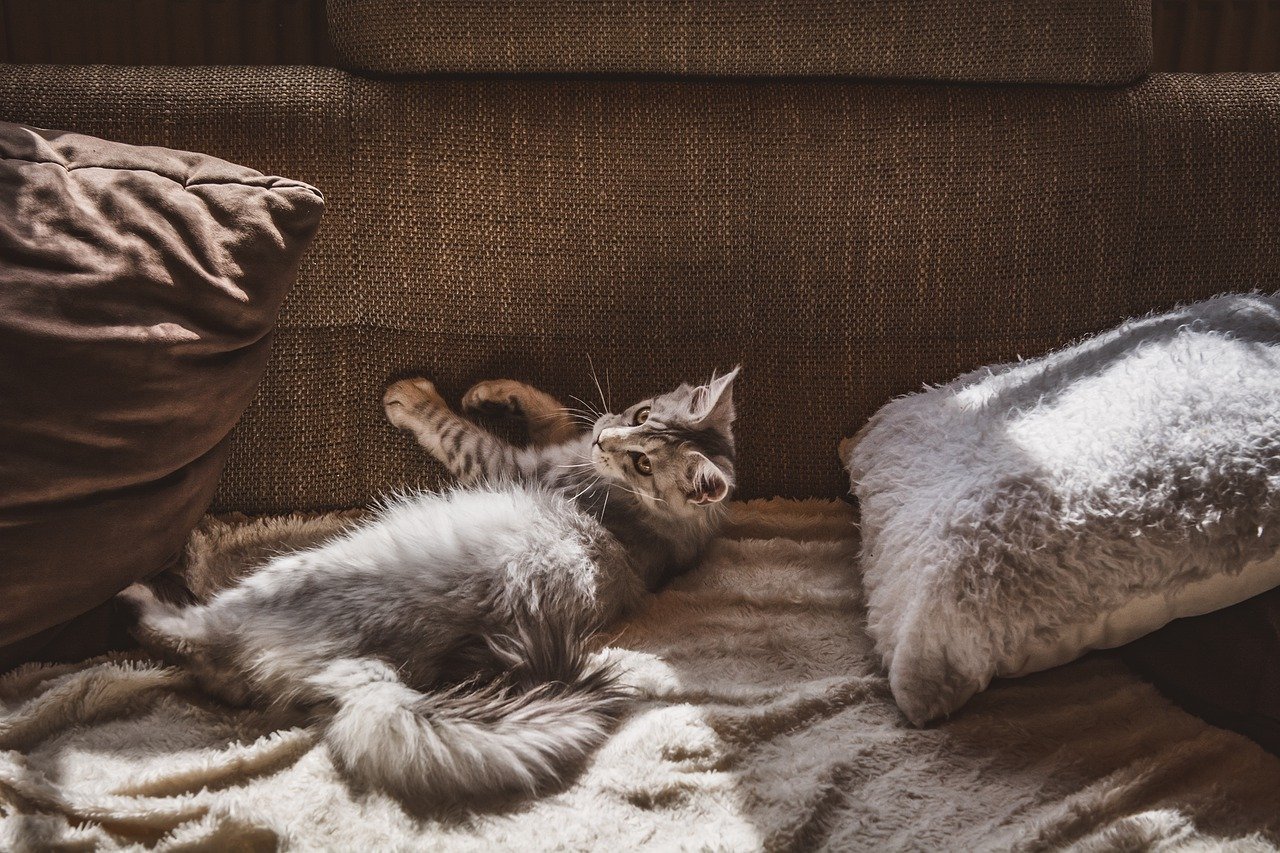
Positive Reinforcement Techniques
When it comes to helping your pet adjust to changes in the home, positive reinforcement can be a game changer. Imagine this: you’ve just moved into a new house, and everything feels foreign and intimidating. Now, picture your furry friend feeling the same way! By using positive reinforcement, you can encourage your pet to explore their new surroundings with confidence and ease. This technique not only helps them adapt but also strengthens the bond you share.
Positive reinforcement involves rewarding your pet for desired behaviors, which can significantly reduce their anxiety during transitions. Think of it as a way to say, "Hey, you're doing great!" For instance, when your pet calmly investigates a new room or interacts with a new toy, shower them with praise or a small treat. This creates a positive association with the new environment. Remember, consistency is key! The more you reward calm and curious behavior, the more likely your pet will feel comfortable exploring their new space.
To effectively implement positive reinforcement, consider incorporating training sessions into your routine. These don’t have to be lengthy or overly complex. Short, engaging sessions can redirect your pet’s focus and provide mental stimulation. For example, you might teach them a new trick or command that encourages them to engage with their surroundings. Not only does this help distract them from their anxiety, but it also gives them a sense of accomplishment, boosting their confidence.
Another essential aspect of positive reinforcement is the strategic use of treats. However, it’s important to choose treats wisely. Opt for healthy options that align with your pet's dietary needs. You wouldn’t want to add more stress to their system by giving them something that could upset their stomach! Consider creating a
| Treat Type | Pet's Reaction | Environment |
|---|---|---|
| Chicken Jerky | Excited | New Living Room |
| Carrot Sticks | Calm | Backyard |
| Peanut Butter | Curious | Kitchen |
In addition to treats and training, don’t forget the power of your voice! Your tone can be incredibly reassuring. Use a calm, upbeat voice to encourage your pet as they explore. This simple act can make a world of difference. Just like we feel comforted by a friendly voice, pets can find solace in your encouraging words. It's all about making them feel safe and supported.
Ultimately, the goal of positive reinforcement is to create a safe and loving environment where your pet feels empowered to adapt. Remember that every pet is unique, and what works for one might not work for another. Be patient and observant, adjusting your techniques based on your pet’s responses. With time, love, and the right approach, your pet will thrive in their new environment, and you’ll both enjoy the journey together!
Q: How long does it take for a pet to adjust to a new environment?
A: The adjustment period varies by pet. Some may adapt within days, while others might take weeks. Patience is key!
Q: Can I use positive reinforcement for older pets?
A: Absolutely! Positive reinforcement can benefit pets of all ages. Just be mindful of their physical limitations and adjust your training accordingly.
Q: What if my pet doesn't respond to treats?
A: If treats aren’t motivating, try using toys, praise, or affection as rewards. Find what excites your pet!
Training Sessions
Engaging your pet in short training sessions can be a game-changer during times of transition. Think of these sessions as a fun workout for your pet's mind! Just like us, pets can get a little anxious when their environment changes, and what better way to redirect that energy than through training? Not only does it keep their minds sharp, but it also strengthens the bond between you and your furry friend.
Start with simple commands that your pet already knows, like sit or stay. This familiarity can provide a sense of comfort amidst the chaos. As they succeed in these tasks, you can gradually introduce new commands or tricks. It’s like going from a warm-up to a full workout—slowly ramping up the intensity keeps them engaged without overwhelming them.
To make the most of these training sessions, keep them short and sweet—around 5 to 10 minutes is ideal. You want to maintain your pet’s enthusiasm, so be sure to end each session on a positive note. You could say something like, “Good job, buddy!” or offer a gentle pet. This positive reinforcement not only boosts their confidence but also makes them look forward to the next session.
Incorporating treats can also be a fantastic motivator. However, it’s essential to choose healthy treats that align with your pet’s dietary needs. Think of it as a reward for a job well done! Use treats strategically, rewarding them after they successfully complete a command or show calm behavior in a new environment. This approach helps them associate the new space or situation with positive experiences.
Overall, remember that the goal of these training sessions is not just to teach commands but to create a sense of normalcy and routine during a time of change. By investing time in training, you’re not only helping your pet adjust but also enhancing their overall well-being. So grab some treats, find a quiet spot, and let the training begin!
- How often should I conduct training sessions?
It's best to have short sessions daily or several times a week to keep your pet engaged without overwhelming them. - What if my pet doesn't respond to training?
Patience is key! Some pets take longer to adjust to new commands, especially during transitions. Keep the sessions positive and consider consulting a professional trainer if needed. - Can training help with my pet's anxiety during changes?
Absolutely! Training provides mental stimulation and can help redirect anxious energy into positive behavior.
Using Treats Wisely
When it comes to helping your pet adjust to changes in their environment, using treats wisely can be a game changer. Think of treats as tiny tokens of encouragement that can help your furry friend navigate through the maze of new experiences. However, it's important to remember that not all treats are created equal. You want to ensure that the treats you offer are not only enticing but also healthy and suitable for your pet's dietary needs. This means avoiding those sugary or fatty options that might please the palate but could lead to health issues down the line.
To make the most out of treat time, consider the following strategies:
- Choose Healthy Options: Opt for treats made from natural ingredients. Look for options that are high in protein and low in fillers. Your pet will appreciate the thoughtfulness, and their body will thank you!
- Use Treats as Rewards: When introducing your pet to new spaces or experiences, use treats to reward calm behavior. This positive reinforcement will help them associate new situations with good feelings.
- Portion Control: It's easy to overindulge our pets, especially when we're trying to comfort them. Keep an eye on portion sizes to avoid unnecessary weight gain. A little goes a long way!
Additionally, you can create a "treat schedule" that aligns with your pet's routine. This consistency not only helps with their diet but also reinforces positive behaviors over time. For instance, if your dog is nervous about a new room, you might give them a treat every time they step inside. Gradually, they’ll begin to associate that space with something positive. Just like how we feel when we receive a compliment, pets thrive on positive reinforcement!
Finally, remember to observe your pet's reactions to different treats. Some pets may have allergies or sensitivities, so it’s wise to introduce new treats one at a time. Keep track of any changes in their behavior or health, and adjust accordingly. By using treats wisely, you're not just rewarding your pet; you're building a bridge of trust and comfort that will help them feel secure during times of change.
Q1: How can I tell if my pet is stressed during a transition?
A1: Look for signs such as excessive barking, hiding, changes in appetite, or unusual aggression. These can be indicators that your pet is feeling uneasy.
Q2: What types of treats are best for training my pet?
A2: Treats that are small, soft, and easy to chew work best for training. They should also be made from high-quality ingredients to ensure they are healthy.
Q3: How often should I give my pet treats during a transition?
A3: Use treats strategically, rewarding your pet for calm behavior or successful exploration of new areas. Just be mindful not to overdo it—balance is key!
Q4: Should I consult a vet before changing my pet's diet?
A4: Yes, it's always a good idea to consult with your veterinarian before introducing new treats, especially if your pet has existing health concerns.

Monitoring Your Pet's Health
When it comes to our furry companions, their health is paramount, especially during times of change in the home. Just like us, pets can experience stress when their surroundings shift, and this can manifest in various ways. Regularly monitoring your pet's health is essential to ensure they are coping well with any transitions. This means keeping an eye on both their physical and mental well-being. After all, a happy pet makes for a happy home!
One of the first steps in monitoring your pet's health is to schedule regular veterinary check-ups. These visits are crucial not just for vaccinations but also for early detection of any potential health issues. A veterinarian can provide valuable insights into how your pet is adjusting to changes and recommend specific strategies tailored to their needs. Remember, just like a car needs regular maintenance, your pet's health requires consistent attention.
Additionally, being observant of your pet's behavior can provide significant clues about their emotional state. Stress in pets can lead to a variety of symptoms, such as:
- Excessive barking or meowing: This can indicate anxiety or discomfort.
- Changes in appetite: Eating less or more than usual can be a sign of stress.
- Hiding or seeking solitude: If your pet suddenly prefers to stay away from family activities, they might be feeling overwhelmed.
- Destructive behavior: Chewing or scratching furniture can be a way of coping with stress.
By being mindful of these signs, you can take proactive steps to help your pet feel more at ease. For instance, if you notice your dog is barking excessively, it might be time to provide them with more exercise or mental stimulation. Engaging them in interactive play or providing puzzle toys can help redirect their energy positively.
In some cases, consulting a professional can be incredibly beneficial. If you find that your pet is struggling significantly with changes, a trainer or animal behaviorist can offer tailored strategies. They can help identify underlying issues and create a customized plan to assist your pet in adjusting to their new environment. Just like a coach helps an athlete improve their performance, a professional can guide you in helping your pet thrive.
Lastly, don't forget the importance of your pet's diet during these transitions. A well-balanced diet contributes to both physical health and emotional stability. If your pet is showing signs of stress, consider discussing their dietary needs with your vet. They may recommend specific foods or supplements that can help soothe anxiety. Think of it as giving your pet a nutritional hug!
Monitoring your pet's health is an ongoing commitment, but it’s one that pays off immensely. By being vigilant and responsive to their needs, you can ensure that your beloved companion not only survives but thrives through any changes in your home.
Q: How can I tell if my pet is stressed?
A: Look for signs such as excessive barking, changes in appetite, hiding, or destructive behavior. If you notice any of these signs, it may be time to reassess their environment.
Q: How often should I take my pet to the vet?
A: Regular check-ups are recommended at least once a year, but if your pet is undergoing significant changes, more frequent visits may be beneficial.
Q: What should I do if my pet refuses to eat?
A: If your pet shows a sudden change in appetite, it's important to consult your veterinarian to rule out any health issues. In the meantime, try offering different types of food or treats to encourage eating.
Q: Can I help my pet adjust to changes at home?
A: Absolutely! Providing a safe space, maintaining routines, and using positive reinforcement can significantly help your pet adjust to new changes.
Signs of Stress to Watch For
When it comes to our furry friends, understanding their emotions is just as important as knowing how to care for them. Pets, like humans, can experience stress, and it’s essential to recognize the signs early on. Ignoring these signs can lead to more significant issues down the road. So, what should you be on the lookout for? Here are some common indicators of stress in pets:
- Excessive Barking or Meowing: If your pet suddenly becomes vocal, it might be their way of expressing anxiety. This can be especially true if they are usually quiet.
- Hiding or Withdrawal: Pets that retreat to corners or under furniture may be feeling overwhelmed. This behavior is their way of seeking comfort and safety.
- Changes in Appetite: A sudden disinterest in food or treats can signal stress. Conversely, some pets might overeat as a coping mechanism.
- Destructive Behavior: If your pet starts chewing on furniture or scratching walls, it may be a sign that they are trying to cope with their anxiety.
- Pacing or Restlessness: Just like us, pets can fidget when they’re anxious. If you notice your pet pacing back and forth, they may be feeling unsettled.
By keeping an eye out for these signs, you can better understand your pet's emotional state and take steps to alleviate their stress. For instance, if you notice excessive barking, it might be a good idea to spend some extra quality time with your pet to help them feel secure. Similarly, if your pet is hiding, consider creating a cozy space where they can retreat and relax. Remember, each pet is unique, and their stress signals may vary. Observing their behavior closely can help you develop a deeper bond with them while ensuring their well-being.
Here are some common questions pet owners have regarding their pets' stress and adjustments to changes in the home:
| Question | Answer |
|---|---|
| How long does it take for a pet to adjust to a new environment? | Adjustment periods vary by pet; typically, it can take anywhere from a few days to several weeks. Patience is key! |
| Can stress in pets lead to health problems? | Absolutely. Prolonged stress can lead to issues such as digestive problems, weakened immune responses, and behavioral issues. |
| What should I do if my pet shows signs of severe stress? | If your pet exhibits severe stress signs, consult a veterinarian or a professional animal behaviorist for guidance. |
| Are there specific breeds more prone to stress? | Some breeds are naturally more anxious than others. However, individual temperament plays a significant role in how a pet handles stress. |
Consulting a Professional
Sometimes, despite our best efforts, our furry friends may struggle to adjust to changes in their environment. This is where consulting a professional can make a world of difference. Professional trainers and animal behaviorists possess the knowledge and experience to identify underlying issues that we, as pet owners, might overlook. They can offer tailored strategies that cater specifically to your pet's unique needs.
When considering professional help, it’s important to choose someone who understands your pet's specific breed and temperament. For instance, some dogs may require more socialization than others, while certain cats might need a gentle approach to new situations. A professional can assess your pet’s behavior and provide insights into how to create a more comfortable transition.
During your consultation, be prepared to discuss your pet’s history, including any past traumas or behavioral issues. This information is crucial for the professional to devise an effective plan. They might suggest a variety of techniques, such as:
- Behavior modification strategies
- Customized training sessions
- Tips for creating a stress-free environment
Moreover, professionals can help you recognize signs of distress that you might not have noticed. For example, did you know that excessive grooming or changes in vocalization can indicate stress? By learning these signs, you can intervene early and prevent further issues.
In addition to behavioral training, a professional might also recommend ways to enrich your pet's environment. This could include introducing new toys, engaging in interactive play, or even suggesting calming supplements that can ease anxiety. Ultimately, the goal is to create a supportive atmosphere that fosters your pet's well-being.
Remember, seeking help from a professional is not a sign of failure; it’s a proactive step towards ensuring your pet's happiness and health. With the right guidance, you can help your beloved companion navigate the changes in their life with confidence and ease.
- When should I consider consulting a professional? If your pet shows persistent signs of stress, such as excessive barking, hiding, or aggression, it might be time to seek professional help.
- How do I find a qualified trainer or behaviorist? Look for professionals with certifications from recognized organizations and positive reviews from other pet owners.
- What can I expect during a consultation? The consultation will typically involve discussing your pet's behavior, history, and any specific concerns you have, followed by personalized recommendations.
- Are there specific training methods that professionals recommend? Yes, many professionals use positive reinforcement techniques, which focus on rewarding desired behaviors rather than punishing unwanted ones.
Frequently Asked Questions
- How can I tell if my pet is stressed during changes at home?
Pets can show signs of stress in various ways. Look out for behaviors like excessive barking, hiding, changes in appetite, or even destructive behavior. It's important to observe your pet closely during transitions to catch these signs early and address their needs.
- What should I include in my pet's safe space?
Creating a safe space for your pet is all about comfort. Include familiar items like their favorite toys, bedding, and blankets that carry their scent. This will help them feel more secure and relaxed during times of change.
- How can I maintain my pet's routine during a move?
Consistency is crucial for pets. Try to keep their feeding, walking, and playtime schedules as regular as possible. This familiarity can ease their anxiety and help them adjust to the new environment more smoothly.
- What are some positive reinforcement techniques I can use?
Using positive reinforcement is a fantastic way to encourage your pet to adapt. Reward them with treats or praise when they display calm behavior in new situations. This not only builds their confidence but also strengthens your bond.
- When should I consult a professional about my pet's behavior?
If you notice that your pet is struggling significantly with changes, it might be time to consult a professional trainer or behaviorist. They can provide tailored strategies to help your pet adjust and thrive in their new environment.
- How often should I take my pet for veterinary check-ups during transitions?
Regular check-ups are essential, especially during significant changes. Aim for at least once a year, but if you notice any behavioral changes or health concerns, don’t hesitate to schedule an appointment sooner.

